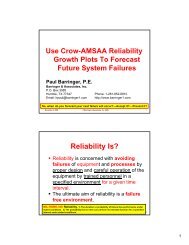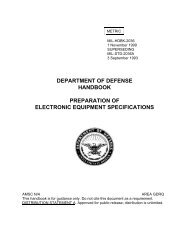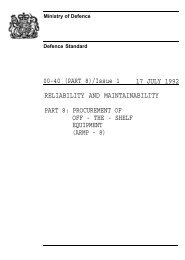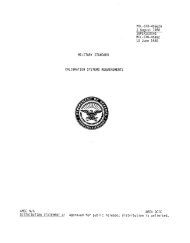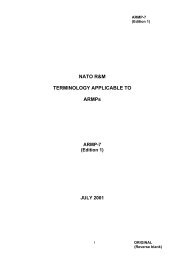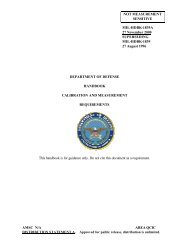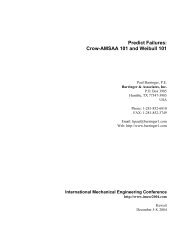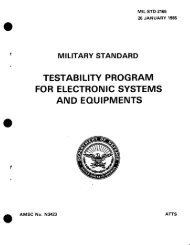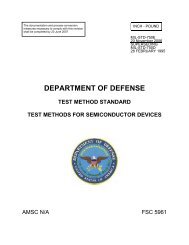MIL-STD-1629-RevA - Barringer and Associates, Inc.
MIL-STD-1629-RevA - Barringer and Associates, Inc.
MIL-STD-1629-RevA - Barringer and Associates, Inc.
Create successful ePaper yourself
Turn your PDF publications into a flip-book with our unique Google optimized e-Paper software.
.MT1.-ST~-l629A4.3.5 Failure definition. The contractor shall develop generalstatements of what congtitute8 a failure of the item in terms of performanceparameters <strong>and</strong> allowable limits for each specified output. The contractor’sgeneral statements shall not conflict with any failure definitionsspecified by the procuring activity.4.3.6 Coordination of effort. Consideration shall be given tothe requirements to perform <strong>and</strong> use the FMECA in support of a reliabilityprogram in accordance with <strong>MIL</strong>-<strong>STD</strong>-785, maintainability program inaccordance with <strong>MIL</strong>-<strong>STD</strong>-470, safety program in accordance with <strong>MIL</strong>-<strong>STD</strong>-882, survivability <strong>and</strong> vulnerability program in accordance with <strong>MIL</strong>-<strong>STD</strong>-2072, logistics support analysis in accordance with <strong>MIL</strong>-<strong>STD</strong>-1388, maintenanceplan analysis (MPA) in accordance with <strong>MIL</strong>-<strong>STD</strong>-2080, fault diagnos~sanalysis in general accordance with <strong>MIL</strong>-sTD-1S91, <strong>and</strong> other contractualprovisions. The contractor shall identify the program organizationresponsible for performing the F’MECA <strong>and</strong> assure that the FMECA resultswill be used by other organizational elements to preclude duplication ofeffort.4.4 General procedure. The FMECA shall be performed inaccordance with the requirements specified herein to systematicallyexamine the system to the lowest indenture level specified by the procuringactivity. The analysis shall identify potential failure modes. Whensystem definitions <strong>and</strong> functional descriptions are not available to thespecified indenture level, the initial analysis shall be perfomed tothe lowest possible indenture level to provide optimum results, Whensystem definitions <strong>and</strong> functional definitions are complete, the analySiSshall be extended to the specified indenture level.4.4.1 Contributing information. System definition requires areview of all descriptive info~ation available on the system to beanalyzed. The following is representative of the information <strong>and</strong> datarequired for system definition <strong>and</strong> analysis.4.4.1.1 Technical specifications <strong>and</strong> development plans . Technicalspecifications <strong>and</strong> development plans generally describe wl]at constitutes<strong>and</strong> contributes to the various types of system failure. These willstate the system objectives <strong>and</strong> specify the design <strong>and</strong> test requirementsfor operation, reliability, <strong>and</strong> maintainability. Detailed informationin the plans will provide operational <strong>and</strong> functional block diagramsshowing the gross functions the system must perform for successfuloperation. Time diagrams <strong>and</strong> charts used to describe system functionalsequence will aid in dctcmining the time-stress as well as feasibilityof various means of failure detection ~nd correction in the operdLingsystem. Acceptable performance limits under specified operating <strong>and</strong>environmental conditions will be given for the system <strong>and</strong> equipments.Information for developing mission <strong>and</strong> environmental profiles willdescribe the mission performance requirements in terms of functionsdescribing the tasks to be performed <strong>and</strong> related to the anticipatedenvironments for each mission phase <strong>and</strong> operating mode. Function-timerelationships from whicl] the time-stress !t’1.{ti(lns}lip of the environmentalb.



